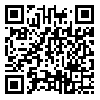BibTeX | RIS | EndNote | Medlars | ProCite | Reference Manager | RefWorks
Send citation to:
URL: http://ismj.bpums.ac.ir/article-1-502-en.html

 , Mohsen . Rezazadeh1
, Mohsen . Rezazadeh1 
 , Hamid Kazemian
, Hamid Kazemian 
 , Nasimeh Fardmousavi
, Nasimeh Fardmousavi 
 , Ehsanallah Ghaznavi-Rad *
, Ehsanallah Ghaznavi-Rad * 
 2
2
2- Molecular Medicine Research Center, Arak University of Medical Sciences, Arak, IRAN , e.ghaznavirad@arakmu.ac.ir
Background: Increasing frequency of Staphylococcus aureus infections and changes in antimicrobial resistance pattern have led to renewed interest in the use of lincosamide– streptogramin B (MLSB) antibiotics for treatment of infections. Since no study has focused on the molecular epidemiology of community -acquired staphylococcus aureus isolates in Iran, the aim of this study was to determine the molecular typing and prevalence of the macrolides-lincosamides-streptogramins B (MLSB) resistance in community associated s.aureus isolated from healthy students at Arak university of Medical sciences. Material and Methods: 568 healthy students from Arak university of Medical sciences were subjected to this study. All samples were subjected to S. aureus–specific isolation procedures. D test was performed to determine various phenotypes as well as spa typing done for molecular typing of these strains. Results: Of 568 the 84 community acquired Staphylococcus aureus, six (7%) were Methiclicin resistant Staphylococcus aureus (CA-MRSA) and 78(93%) were Methicillin sensitive Staphylococcus aureus (CA-MSSA) of the 84 s.aureus strains, eight (9.5%) showed constitutive resistance with spa type t660, t701, t304, t5598, t012, t3204, t084 and t1944. Two strains (2.5%) demonstrated inducible resistance with spa type t9024, t077, two strains (2.5%) were D test negative with spa type t084 and t1149. 72(85.5%) strains. Illustrated susceptible Phenotype. Among CA-MRSA isolates, two strains had constitutive resistance and four remaining CA-MRSA had susceptible phenotype Conclusion: The result of this study indicates that in community associated s.aureus strains, constitutive MLSB resistance rate is higher than the rate of inducible resistance. Presence of inducible resistance to clindamycin in CA-MRSA strains, warrants that D test should be performed to detect this type of resistance. All isolates with inducible and constitutive resistance and D zone negative strains had different molecular typings.
Received: 2012/05/28 | Accepted: 2012/07/1 | Published: 2014/02/1
| Rights and Permissions | |
 |
This work is licensed under a Creative Commons Attribution-NonCommercial 4.0 International License. |



